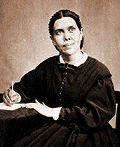|
What meaning then was attached to Christ's
presentation! But the priest did not see through the veil; he did
not read the mystery beyond. The presentation of infants was a
common scene. Day after day the priest
received the redemption money as the babes were presented to the
Lord. Day after day he went through the routine of his work,
giving little heed to the parents or
children, unless he saw some indication
of the wealth or high rank of the
parents. Joseph and Mary were poor; and
when they came with their child, the priests saw only
a man and woman dressed as
Galileans, and in the humblest
garments. There was nothing in
their appearance to attract attention, and they presented only the offering made by the poorer
classes.
The priest went through the ceremony of his
official work. He took the child in his arms, and
held it up before
the altar. After handing
it back to its mother, he
inscribed the name "Jesus" on the
roll of the first-born.
Little did he think, as the babe
lay in his arms, that it was the Majesty of heaven, the King
of glory. The priest did not think that this babe was the One
of whom Moses had written, "A Prophet shall the Lord your God
raise up unto you of your brethren, like unto me; Him shall
ye hear in all things whatsoever He shall say unto you." Acts
3:22. He did not think that this babe was He whose glory
Moses had asked to see. But One greater
than Moses lay in the priest's
arms; and when he
enrolled the child's name, he was enrolling the name of One
who was the foundation of the whole Jewish economy. That name was to be its death warrant; for the system of sacrifices
and offerings was waxing old; the
type had almost reached its antitype, the shadow its
substance. |
There were few more
common, few less noticeable sights than the one
witnessed that forenoon within the temple when Christ's
presentation as a first-born
child took place. It happened every
day that mothers brought their children to be in this way dedicated
and redeemed. It was part of the daily routine work of the priest-in-waiting to take their
payments, to hold up the children
before the altar, to enroll their
names in the register of the first-born, and so to complete the
dedication; a work which from its commonness he went through
without giving much attention either to parents
or to child, unless indeed there
was something special in their rank, of
their
page 33
appearance, or their offerings.9
But here was nothing of the kind.
A10
poor man and woman,
in humblest
guise, with humblest offerings, present themselves before
him. The woman holds out her first-born babe; he takes,
presents, enrolls, and hands
it back to her;
all seems over, and what is there in so common, plain, and
simple an old Jewish custom worthy of any particular
notice?11, 12
We shall be able to
answer that question better, by considering for a moment what
this rite of the dedication of the first-born among the
Israelites really meant, especially as applied to this
first-born, to this child Jesus.
[3 paragraphs are skipped over, to page 35]
How little did
that Jewish priest, who took the infant Saviour and held him up
before the altar, imagine that a greater than
Moses, one greater than the temple, was in his
arms!12 How
little did he imagine, as he inscribed the new
name Jesus in the
roll of the first-born of Israel, that he was signing the
death-warrant of the Mosaic
economy now waxing old and ready to vanish
away; that he was ushering in that better,
brighter day, when neither of the temple upon Mount Zion, nor
that upon Gerizim, it should be said that
page 36
there only was the true worship of Jehovah
celebrated; but when, taught by this very Jesus to know God as our
Father in heaven, unfettered and redeemed humanity in every land
should worship him who is a Spirit in spirit and in truth.
[This paragraph continues for another 13 lines or 4
sentences—see comparison for paragraph 12.] |
And when the days of her purification according to the law of Moses were accomplished,
they brought him to Jerusalem, to present him to the Lord. (Luke 2:22)
And if she be not able to bring a lamb, then she shall bring two turtles,
or two young pigeons; the one for the burnt offering, and the other for a
sin offering: and the priest shall make an atonement
for her, and she shall be clean. (Lev. 12:8)
In that he saith, A new covenant, he hath made the first old. Now that which
decayeth and waxeth old is ready to vanish away. (Heb. 8:13)
|


